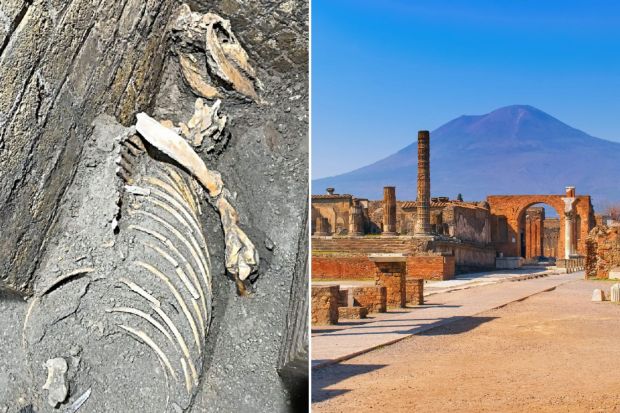Science
New Evidence Shows Romans Returned to Pompeii After Eruption

New archaeological findings indicate that Romans returned to the ruins of Pompeii following the catastrophic eruption of Mount Vesuvius in 79 AD. This new evidence sheds light on the aftermath of the volcanic disaster, challenging the long-held belief that survivors fled the devastated city and never returned.
Pompeii, located in the Campania region of Italy, was buried under a thick layer of ash and pumice, leading to the loss of thousands of lives. While the exact death toll remains uncertain, estimates suggest that between 15% and 20% of the population perished due to thermal shock and the subsequent engulfing ash cloud. The city lay hidden for nearly 1,500 years until its rediscovery in the late 16th century.
Recent excavations have revealed compelling signs that some former residents returned to the site, albeit under different circumstances. Researchers believe that those who returned were primarily from the lower socioeconomic strata, unable to afford relocation. Many sought to reclaim valuables left behind in the ruins. Evidence suggests that while the upper floors of buildings saw some habitation, the ground floors were repurposed into cellars equipped with ovens and mills.
Transforming Pompeii: A New Perspective
According to Gabriel Zuchtriegel, site director of the Pompeii Archaeological Park, the city post-eruption resembled “a precarious and grey agglomeration, a kind of camp, a favela among the still-recognizable ruins of the Pompeii that once was.” This characterization contrasts sharply with the vibrant city depicted in earlier studies focused on its art and architecture.
In the past, hints of this reoccupation existed but were often overlooked in the rush to uncover Pompeii’s famed frescoes and intact structures. Zuchtriegel noted that, “the faint traces of the site’s reoccupation were literally removed and often swept away without any documentation.” This oversight has contributed to a skewed understanding of the city’s history following the catastrophic eruption.
Research indicates that Pompeii may have continued as an informal settlement until around the 5th century. The conditions faced by returning inhabitants were harsh, lacking the infrastructure and services that had characterized the ancient city. Archaeologists emphasize that this new understanding of post-eruption life is crucial for a complete historical narrative of Pompeii.
The Eruption’s Historical Context
The eruption of Mount Vesuvius in 79 AD was one of the most violent volcanic events in history, burying Pompeii and the nearby town of Herculaneum under volcanic ash. The thermal energy released by the eruption was estimated to be 100,000 times greater than that of the atomic bombings in Hiroshima and Nagasaki.
The remains of Pompeii have been remarkably well-preserved, with layers of ash creating a protective barrier against air and moisture. During excavations, archaeologists have utilized plaster to fill voids left by bodies, allowing the recreation of their final poses. This method has provided invaluable insights into the human cost of the eruption.
Mount Vesuvius is considered one of the most dangerous volcanoes in the world, having erupted numerous times since 1944. Although currently classified as dormant, experts regard it as an “extremely active” and unpredictable volcano, posing an ongoing risk to the approximately three million people living in its shadow.
The latest discoveries in Pompeii continue to reveal the complexities of life in the ancient city and its enduring legacy. Excavations conducted in February 2023 uncovered the remains of a child who perished during the eruption, serving as a poignant reminder of the human tragedy that unfolded nearly two millennia ago.
-

 Entertainment1 week ago
Entertainment1 week agoAimee Osbourne Joins Family for Emotional Tribute to Ozzy
-

 Politics2 weeks ago
Politics2 weeks agoDanny Healy-Rae Considers Complaint After Altercation with Garda
-

 Top Stories3 weeks ago
Top Stories3 weeks agoFianna Fáil TDs Urgently Consider Maire Geoghegan-Quinn for Presidency
-

 World3 weeks ago
World3 weeks agoHawaii Commemorates 80 Years Since Hiroshima Bombing with Ceremony
-

 World3 weeks ago
World3 weeks agoGaza Aid Distribution Tragedy: 20 Killed Amid Ongoing Violence
-

 World3 weeks ago
World3 weeks agoCouple Convicted of Murdering Two-Year-Old Grandson in Wales
-

 Top Stories4 weeks ago
Top Stories4 weeks agoClashes Erupt Between Far-Right Groups and Migrants in Spain
-

 World4 weeks ago
World4 weeks agoAristocrat Constance Marten and Partner Convicted of Infant Murder
-

 Top Stories3 weeks ago
Top Stories3 weeks agoHistoric Dalkey Pub The Queens Reopens Under New Management
-

 World3 weeks ago
World3 weeks agoTrump Defends FBI Deputy Director Amid Epstein Files Controversy
-

 Business4 weeks ago
Business4 weeks agoSunshine 106.8 Boosts Irish Music After Regulator’s Request
-

 Politics3 weeks ago
Politics3 weeks agoTragic Crowd Surge at Gaza Aid Center Claims 20 Lives









